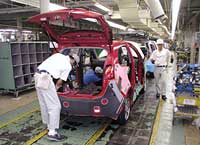|
|
|||||||
|
|
|||||||
|
|||||||
| | Web Japan >> | Trends in Japan >> | Business & Economy >> | Keiretsu Comeback | |
|
KEIRETSU COMEBACK Conglomerates Are Back in Fashion (September 5, 2005) Keiretsu (corporate conglomerates) have been condemned by European and American auto makers for their opaque business practices and high costs. In the 1990s Western business practices began to gain ground among Japanese manufacturers, who were drawn to the emphasis on price competitiveness, but today keiretsu are being reevaluated as a way to achieve business success. The Japanese style of close cooperation between a producer and its parts suppliers in one group is coming to be viewed as a way to cut costs and raise productivity to meet increased foreign demand from China and other countries. Back from the Dead Japanese car exports surged in the 1970s in the wake of the oil crises, as consumers in the United States and elsewhere discovered that these vehicles offered high quality and fuel efficiency at low prices. This led to mounting trade friction between Japan and the United States in the 1980s, particularly over automobiles, and Japanese manufacturers came under criticism for their keiretsu dealings and other practices. In response, they established new production bases in the United States and made great efforts to defuse the tension. Some of Japan's big auto makers decided to purchase more US components in order to raise the ratio of locally produced parts used in their vehicles. The collapse of the economic bubble in the early 1990s pushed some Japanese companies to the brink of bankruptcy, and some sought to survive by joining or reinforcing their ties with foreign corporate groups. Foreign producers that provided capital to Japanese companies were not concerned with keiretsu ties and were determined to cut costs by placing large orders with suppliers who put in the lowest bid. Nissan Motor Co. is a case in point. Under the leadership of Carlos Ghosn, who was dispatched by Nissan's parent company, France's Renault SA, a restructuring plan was implemented that included limiting the number of suppliers and withdrawing the financing Nissan provided to almost all of the 1,400 firms in its group. The resulting cut in costs ultimately made the company profitable again. The Impact on Parts Makers Major parts suppliers are feeling the effects of the winds of change. Until now Honda Motor Co. stood by a policy of developing its own core technology, and it did not have a group of affiliated parts suppliers like the other big manufacturers. It recently changed course, however, and asked suppliers to cooperate in boosting productivity to keep pace with the growing Chinese economy. Honda also plans on becoming the major shareholder in Nihon Plast Co., an air bag and plastic parts maker. Meanwhile, in January 2005 Nissan raised its stake in Calsonic Kansei Corporation, which specializes in the production of modules assembled from multiple parts, from 27.6% to 41.7%. And in June Toyota Motor Corporation for the first time directly dispatched a Toyota executive to Aisin Seiki Co., an affiliated firm, to assume the post of president and strengthen the group's management. Some car industry analysts believe that the advantages of keiretsu will continue to be revealed as Japanese manufacturers step up their overseas production. Copyright (c) 2005 Web Japan. Edited by Japan Echo Inc. based on domestic Japanese news sources. Articles presented here are offered for reference purposes and do not necessarily represent the policy or views of the Japanese Government. |
MANUFACTURING SUCCESS (February 28, 2005) IN WITH THE NEW (January 17, 2005) MOLDING THE FUTURE (November 28, 2003) TURNING POINT (August 7, 2003) |
|
|



